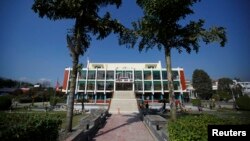So far the most buzz surrounding this week's SAARC summit has been the Pakistani prime minister's refusal to use an India-made bulletproof car during the upcoming events.
India has provided six bulletproof cars to Nepal, which is hosting the 18th annual summit of the South Asian Association for Regional Cooperation on Wednesday and Thursday.
Leaders of India, Pakistan, Sri Lanka, Afghanistan, Nepal, Bangladesh, Maldives and Bhutan will attend, and the cars from India were meant to ferry them safely during the summit.
Some regional analysts say Pakistani Prime Minister Nawaz Sharif's decision to use his own car signifies a larger problem that has slowed SAARC's progress over the years — mistrust between India and Pakistan, the group's two biggest countries.
“If there are issues between India and Pakistan it boils down to the region and everything is put on hold,” said Yurendra Basnett of London's Overseas Development Institute.
Regional leaders founded SAARC in 1985, aiming to tackle the social and economic challenges of the region. But almost three decades later, SAARC has not achieved much. Many critics say that it has become just a “talking shop” that produces little action.
According to the regional news media, this year's summit will not challenge that criticism. Poverty alleviation, climate change, energy cooperation and improving regional connectivity are some of the issues that will figure in the summit declaration. The leaders also are expected to sign a motor vehicle agreement to improve transportation among SAARC countries.
“SAARC declarations are always full of big promises, the problem is implementation,” says Basnett.
But SAARC has achieved milestones, such as the South Asian Free Trade Agreement (SAFTA) to promote trade; the SAARC Development Fund to finance projects and programs; and a South Asian University for students of SAARC countries.
At the South Asia Economic Summit in New Delhi recently, India's former foreign secretary Shyam Saran listed those achievements, but conceded that “SAARC has been unable to promote truly collaborative projects among its members.”
SAARC has been unable to realize its potential because of its inability to develop institutions to facilitate program implementation, says Kishore C. Dash, associate professor of international studies at Thunderbird School of Global Management in the United States.
Today, SAARC is far behind other regional groups, such as the Association for Southeast Asian Nations (ASEAN), when it comes to integration.
One sign of the bloc's lacking economic integration: trade among SAARC countries is just around five percent of their total trade.
Benefits of Shared Prosperity Elusive
One of the reasons SAARC leaders have not followed through on their promises is the lack of public accountability.
Because SAARC projects do not affect daily life for most people, the public does not care about the group, and, says Basnett, that is why people do not hold their leaders responsible. "No one asks what was declared and what was implemented,” he adds.
This is in contrast to ASEAN, where people think their economic well-being is linked to the region. ASEAN countries are connected by a complex web of production networks and people are able to see the benefits of shared prosperity.
In ASEAN, it is common for products to move a couple of times across the borders before getting shipped to Europe or America, and this shared interest forces countries to come to the table to address regional issues, Basnett says.
Moreover, Kishore Dash says his research shows that despite of shared history and culture, South Asians do not have a sense of shared identity like Europeans or South East Asians.
“Regional identity is not developed and is not creating the kind of glue,” like European identity in case of European Union or Southeast Asian identity in case of ASEAN, contends Dash.
Connectivity Key Issue
One of the main reasons that cross-border production networks have not developed and people do not feel connected to South Asia is lack of connectivity — not just in terms of physical infrastructure but also in terms of systems and services that enable cross border movement.
Today, South Asia is the least integrated region of the world, Basnett says. “It is easier for people to go to Europe than to go from one country to another in the region,” adds Basnett who comes from Nepal.
Lack of connectivity, logistical issues and regulatory barriers dissuade businesses from dealing with each other even when there is a compelling reason to do so.
At this summit, however, SAARC leaders will are expected to address this issue in this week's summit by signing a motor vehicle agreement which will make it easier for vehicles, both personal and cargo, to cross borders.
SAARC's Future
When it comes to SAARC, it often is said that if India doesn't move, nothing moves. Many regional analysts are hopeful conditions are right for India to take the lead, thinking the new Narendra Modi government in Delhi, with its focus on economic growth, has the potential and will to strengthen SAARC's economic integration. Some foreign policy experts say Modi's invitation to SAARC leaders to attend his swearing-in ceremony and his visits to Nepal and Bhutan within months of becoming prime minister, show that the neighborhood is his priority.
On the other side of the border, Pakistan's Prime Minister Sharif is a strong proponent of increasing trade ties with India.
But relations between Indian and Pakistan have deteriorated in the past few months, and, historically, it has been impossible for SAARC to achieve anything if there is tension between the two countries.
Those tensions risk overshadowing this week's summit. There have been no indications Modi and Sharif will meet on the sidelines in Kathmandu.
The biggest hope for SAARC is that dialogue continues at the highest level. Dash at the Thunderbird School says this in itself is a significant achievement for SAARC.






